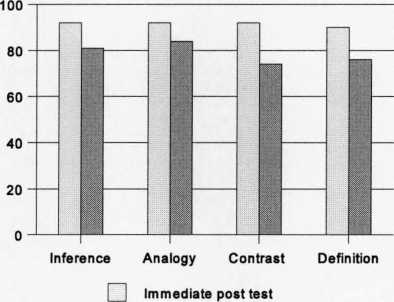To what extent does children ,s performance on the multiple choice task differ by linguistic
condition?
If all children from each linguistic condition (48 participants) were correct on the two target
words, the maximum total score would be 96 for each linguistic condition in each post test.
Figure 5.6 below shows children’s performance on the multiple choice task by linguistic
condition for both post tests. As the figure illustrates all the children from the different
linguistic conditions performed at the same level (ceiling effect). Statistical analysis revealed
no significant differences. Linguistic condition differences within each age group were also
investigated. The same pattern was found within each age group as before.
Figure 5.6 Total number of correct responses in the multiple choice task by linguistic
condition for both post tests

■ I Delayed post test
To what extent does children ,s success in the multiple choice task change between the
immediate and delayed post test ?
During the immediate post test there were 95.3% correct responses while in the delayed post
test 82% correct responses. Statistical comparison between the two post tests revealed that
children performed significantly better during the immediate than the delayed post test
(Wilcoxon: Z=4.8, p<.0000). Comparison of children’s performance between the two post
tests within each age group revealed the same pattern for the 4 year-olds (Wilcoxon: Z=2.1,
p<.05) the 5 year-olds (Wilcoxon: Z=3.5, p<.0005) and the 6 year-olds (Wilcoxon: Z=2.5,
p<.05).
Comparison of children’s performance between the two post tests within each linguistic
condition revealed the same pattern for the Inference (Wilcoxon, Z=2.5, p<.05), Analogy
123
More intriguing information
1. The name is absent2. Social Balance Theory
3. An Attempt to 2
4. Fiscal federalism and Fiscal Autonomy: Lessons for the UK from other Industrialised Countries
5. The resources and strategies that 10-11 year old boys use to construct masculinities in the school setting
6. An Incentive System for Salmonella Control in the Pork Supply Chain
7. The name is absent
8. AN ECONOMIC EVALUATION OF COTTON AND PEANUT RESEARCH IN SOUTHEASTERN UNITED STATES
9. Solidaristic Wage Bargaining
10. The Provisions on Geographical Indications in the TRIPS Agreement